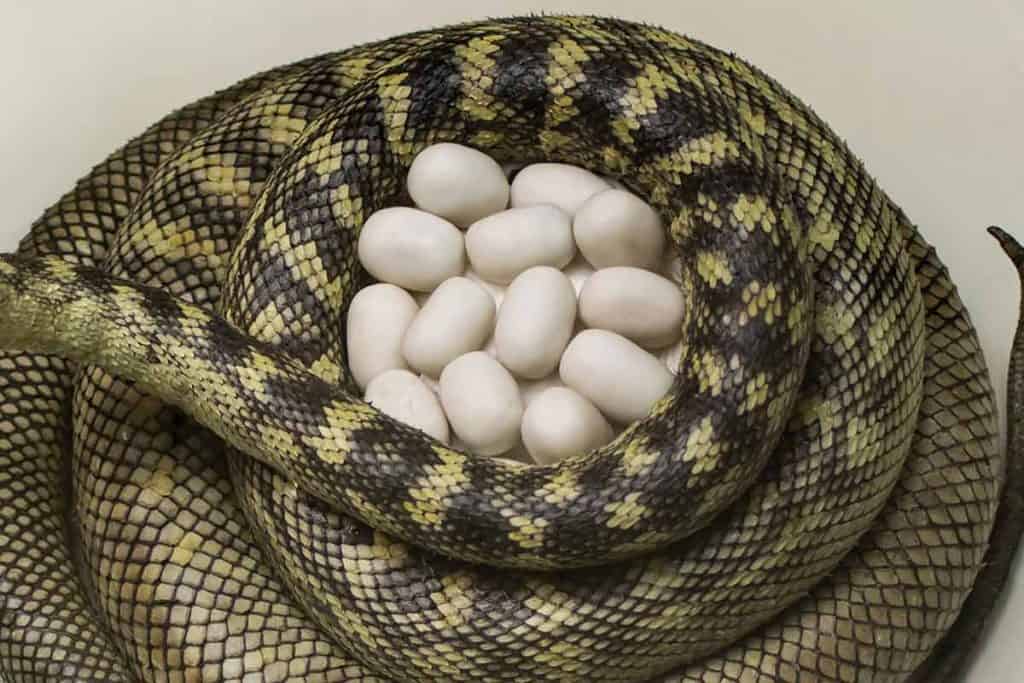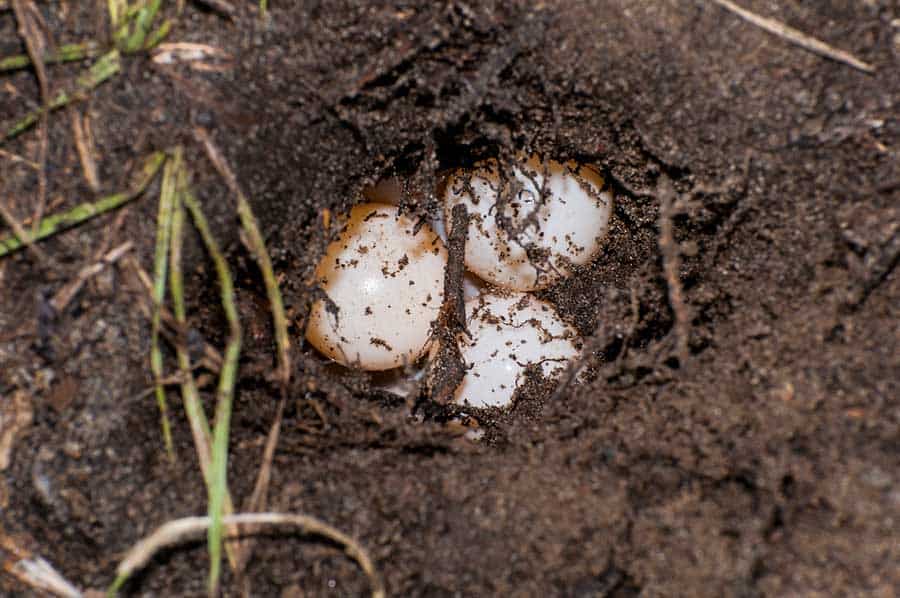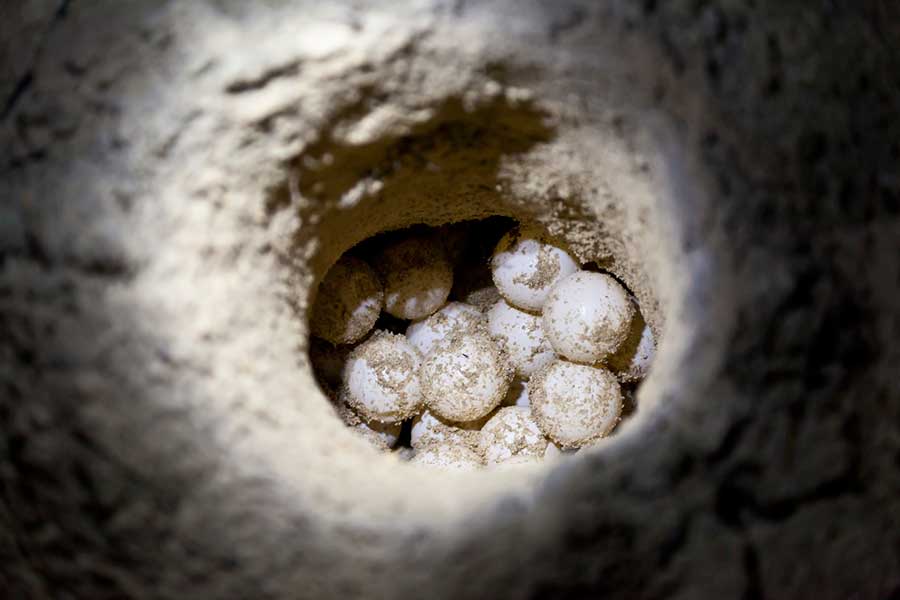Some snake eggs and turtle eggs can look quite similar but it’s important to know the difference. After all, turtle eggs are harmless, whereas venomous snakes can be deadly right out of the egg!
Being able to determine what eggs may have been laid in your back garden or along your favorite hiking path is important for the preservation of the eggs, and can even be life-saving knowledge!
With our snake eggs vs turtle eggs checklist you’ll be able to tell immediately what sort of clutch you’ve found.
So read on to find out about the key differences between snake and turtle eggs.
Differences Between Snake Eggs vs Turtle Eggs (5 Point Checklist)
Snake eggs have a rather distinct shape and feel, whereas turtle eggs can be a little more difficult to identify because they often vary quite widely in texture and appearance.
The main differences between snake eggs vs turtle eggs are:
Shape
- Snake eggs are oval in shape
- Turtle eggs are rounder
Size
- Turtle eggs are very small, usually under an inch long
- Snake eggs are usually over an inch in length
Texture
- Snake eggs are softer with a slightly rubbery or leathery texture
- Turtle eggs are usually soft and leathery but some species also lay hard-shelled eggs likes birds
Color
- Snake eggs are usually white or off-white
- Turtle eggs are creamy colored
Location
- Snake eggs are usually found above ground or in leaf litter (apart from a few snake species who lay in burrows or in trees)
- Turtle eggs are always buried
If you’re still unsure what kind of reptile eggs you have found, read on to learn more about the essential differences.
Snake Eggs Overview
About 70% of snakes lay eggs – the other 30% are viviparous or ovoviviparous which means they give birth to live young.
Snake Reproduction Method
Snake eggs have very typical-looking oval-shaped eggs. Many snake eggs look so similar to one another that it is difficult to tell the species apart based only on the eggs, even for the experts!
How Do Snake Eggs Look?
The color of snake eggs is usually whitish or off-white in color. They almost look like an overgrown, slightly dirty Tic-Tac! They do not have any natural patterns on them, and they do not come in different colors like some chicken eggs.
If you find a snake egg that has green, blue, or black markings on it, then it is most likely that the embryo has died and the egg is rotting.
If you shine a light through the shell, you will be able to see the little snake developing inside the egg! This process is known as “candling,” and it can be useful if you want to check the development of many kinds of reptiles’ eggs. Just be gentle!
What Do Snake Eggs Feel Like?
Unlike hard-shelled bird eggs, snake eggs are leathery or rubbery. The shells are soft and semi-permeable, so that water can enter through the shell.
The typical snake egg feels like a small water balloon that is filled up halfway with jelly. As water enters the leathery shell during the course of incubation, the egg will swell in size to allow space for the snake to grow.
Be very careful when handling a snake egg – if you’re not careful you can detach the embryo from the shell wall which could cause the snake to die. When handling eggs, never squeeze them, shake them, or turn them upside down.
Snake eggs will also often be covered in a mucus that, once dry, will stick the eggs together. If you pick up the eggs, you might tear eggs that are stuck together apart and kill the embryos.
Where Will You Find Snake Eggs?
Snakes generally lay their eggs in nests on the ground, in hollow trees, or under leaf litter. The nest will usually be dark and humid.
This is to keep the eggs safe from predators as well as to keep them well-hydrated and prevent them from drying out and dying.
Read our essential guide to identifying snake eggs.
How Do Snakes Lay Eggs?
Female snakes lay between 10 and 100 eggs depending on the species.
The average snake incubation period is around 60 days, although it depends on the species, for example Corn Snakes typically take about 8 weeks to hatch.
Most female snakes leave the clutch as soon as they have finished laying the eggs. Although a few species like pythons stay with the eggs to keep them warm and protect them.
If you’re incubating snake eggs at home, then the hatch rate will depend on the temperature of your incubator.
Turtle Eggs Overview
While the color and texture of some turtle eggs can be easily confused with snake eggs, a turtle’s reproduction method is actually very different.
Turtle Reproduction Method
All turtles are strictly oviparous. That means they only lay eggs and do not give live birth.
This is because the space inside a turtle’s shell is limited, and the opening of their shell where their cloaca is only big enough for eggs.
How Do Turtle Eggs Look?
Turtle eggs are white to creamy yellow in color. This immediately sets them apart from snake eggs.
Turtle eggs are round like a ping pong ball although some turtle species have more oblong eggs like a snake. They will not be the same shape as an oval bird’s egg with a tapered tip.
So, if snake eggs and turtle eggs can both be oblong, then how can you tell the difference?
Well, turtle eggs are very small. If the egg you’ve found is over an inch in length, then it is likely a snake’s egg. If it is under an inch long, then it is most likely a turtle’s egg if you can match it up with other physical characteristics such as texture.
The size of a turtle’s egg is in direct comparison to the size of the turtle. Small turtles, like red-eared sliders for example, will have smaller eggs, and larger turtles like land tortoises will have larger eggs.
What Do Turtle Eggs Feel Like?
Turtle eggs can range from having hard shells to spongy, soft shells depending on the turtle species (for example sea turtles have. The harder the turtle’s eggshell is, the less permeable it is, which means it will not let in as much water.
There is a plus side to this feature: It will not dry out as fast as other animals’ eggs that are more permeable.
Where Will You Find Turtle Eggs?
Turtles are aquatic or semi-aquatic reptiles. They only come onto dry land to lay their eggs. This is because their eggs cannot survive underwater as they are slightly permeable.
The non-aquatic exception would be land turtles, also known as tortoises!
All turtle eggs (aquatic, semi-aquatic, and non-aquatic) will be buried to a certain degree in warm, moist sand. Most species of turtles need a humidity level of 70% to incubate correctly.
You will generally find turtle eggs in river banks, on beaches above the high tide mark, and in damp soil around swamps and bogs.
Turtle Egg Incubation
Female turtles will lay their eggs about 3 – 6 weeks after mating. They spend about 3 hours digging their nest, laying the eggs and then covering them in sand before returning to the water.
The eggs will then incubate in the warm sand for about 45 to 70 days. Interestingly, the sex of a turtle embryo is dependent on the temperature of the nest.
FAQs About Turtle and Snake Eggs
Are Snake Eggs and Turtle Eggs Incubated at the Same Temperature?
Snake and turtle eggs are incubated at different temperatures and in different conditions. This also extends to the different species of turtles and snakes.
If you are unsure of what kind of egg you have and the correct incubation temperature, take it to your local exotic vet or breeder. They may be able to identify the egg for you.
Are Turtle Eggs Soft?
Most types of turtle eggs are slightly soft and malleable, like a spongy ping pong ball. However there are some species like mud turtles that lay hard eggs.
How Big is a Clutch of Snake Eggs Versus a Clutch of Turtle Eggs?
Smaller species of turtles will lay small clutches because they have a limited amount of space inside their rigid shells for the eggs to develop before being laid.
On the other hand, larger turtles usually lay large clutches. Leatherback turtles, for example, lay an average of 100 eggs per clutch!
A snake’s clutch size will vary according to their species and whether they are viviparous, oviparous, or ovoviviparous.
Check out our guide on which snakes give birth to live babies.!
What Must I Do If I Find a Nest of Turtle Eggs or Snake Eggs?
If you stumble upon a clutch of eggs while you are out on a hike or relaxing on a beach, then the best advice would be to leave the eggs where they are. If you are on a nature reserve or protected land, then you could report the clutch of eggs to the local wildlife authorities.
However, if you come across a clutch of eggs where they should not be, for example, in your backyard or an area of high traffic, you should call in your local animal rescue so that they can relocate the eggs to a safer place.
Most venomous species of snake in North America give birth to live young, so the chance of the eggs hatching out to snakes that can harm you is small.
Babies Hatching
Next time you stumble across a clutch of whitish eggs on the ground that are most definitely not bird eggs, have a look at our turtle eggs vs snake eggs checklist to help identify them.
Remember to always be respectful and careful when handling eggs, as they are delicate and hold precious reptile babies inside!




